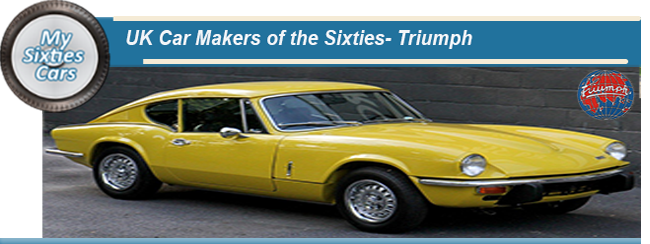
That was when a talented young engineer by the name of Siegfried Bettmann, left his family home in the city of Nuremberg to seek his fortune in Great Britain.
With the UK a hotbed of opportunity in those days, the young Siegfried soon met up with a fellow German expatriate by the name of Mauritz Schulte also looking to find his niche in the industry.
The pair decided to pull their talents, ambition and capital, to establish a cycle manufacturing works in the Midlands city of Coventry, at that time the centre of the UK motor industry. Bettmann and Schulte named the new company Triumph, and soon diversified into producing the latest two-wheeled wonders- motorcycles.
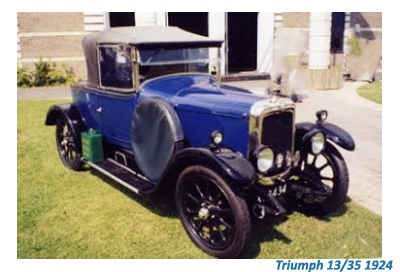 Over the years, Triumph grew to become one of the largest motorcycle manufacturers in the world.
Over the years, Triumph grew to become one of the largest motorcycle manufacturers in the world.
Encouraged by their success, Bettmann and Schulte decided that the time was right to expand outwards and upwards, expanding into manufacture of four-wheel cars.
The first Triumph car, launched in 1923, was nowhere near as well accepted as the partners had hoped, meaning that in very little time, the partners decided to make a rapid withdrawal from car manufacturing, putting the Triumph motor company was put up for sale.
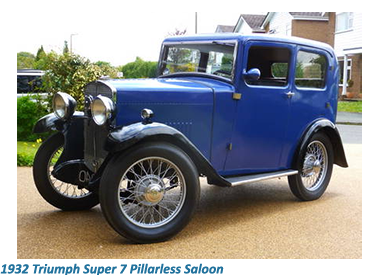 After changing hands a few times in the Thirties, Sir John Black owner of the Standard Motor Company acquired Triumph in 1944, forming the Standard/Triumph Group.
After changing hands a few times in the Thirties, Sir John Black owner of the Standard Motor Company acquired Triumph in 1944, forming the Standard/Triumph Group.
As soon as the Second World War was over, Triumph Company wasted little time in introducing two new cars, the first, the simply titled the Roadster, a 2+2 soft-top.
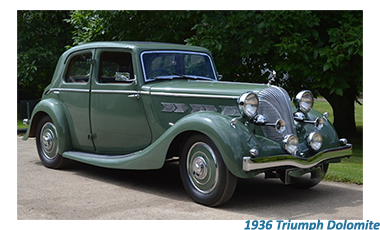 While many companies were still using pre-war designs, the 2+2 soft-top’s design was decidedly post-war with enough space for two rear-seat passengers to sit in relative comfort.
While many companies were still using pre-war designs, the 2+2 soft-top’s design was decidedly post-war with enough space for two rear-seat passengers to sit in relative comfort.
At the same time as they released their Roadster, Triumph launched a spacious family saloon, initially titled the 2000, soon renamed the Renown.
Next to follow was the Mayflower, virtually a scaled-down version the Renown. From that launching board, and through to the end of the Sixties, Triumph established a firm footing in the sports car and saloon categories.
During the Fifties, Triumph ran a range of open-top tourers starting from the TR2, followed up by the TR3 in 1956. With the release of the TR3 sales began to really boom for the company, particularly in the export markets where UK soft tops were in high demand.
![]()
At the start of the Sixties, Triumph were offering only two basic models, the TR3A sports and the small one litre Herald saloon which was unusual in that it featured all-independent suspension at a time when fitting a live rear axle was virtually universal in vehicles of this class.
The little Herald saloon was available in two versions; a two-door four-seat saloon, and a two-door two-seat coupe.
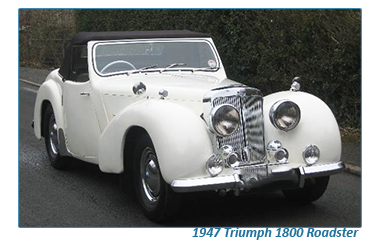 Styled by Michelotti in Italy, the Herald had a pert compact appearance, with small tail fins and an angular roofline.
Styled by Michelotti in Italy, the Herald had a pert compact appearance, with small tail fins and an angular roofline.
A double-backbone chassis was used with body panels bolted to it, while a front-hinged all-enveloping bonnet gave first-rate access to the 948-cc four-cylinder engine which had appeared in original form in the Standard 8.
In June 1960 the Triumph Herald convertible, a top export seller, was made available to the UK public, with surprisingly strong sales recorded, despite the traditionally wet summers.
In the spring of 1961, a larger-engined version of the Herald was released, the 1200, fitted with a large-bore 1147-cc version of the I-litre power unit.
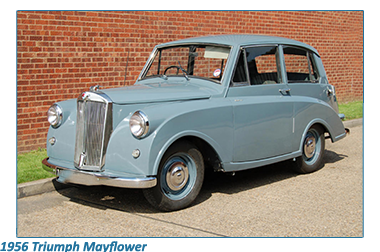 The 1200 was identical in appearance to its smaller-engined version, apart from 'Herald' lettering above the grille and a '1200' emblem on the boot.
The 1200 was identical in appearance to its smaller-engined version, apart from 'Herald' lettering above the grille and a '1200' emblem on the boot.
An attractive walnut veneer fascia was introduced, while a lockable glovebox, white rubber bumpers, improved seats with a fixed rear seat squab.
In June of that year, the fixed-head coupe version of the Herald was also released, again to an enthusiastic audience.
With Triumph squeezing every drop of sales value from the Herald design.
In May of 1962 a six-cylinder engined version of the Herald was released, to be marketed as the Vitesse.
The most noticeable difference between the Herald and the Vitesse was the latter’s front-hinged bonnet with angular dual headlamps.
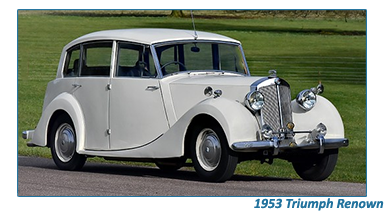 Also on offer was the TR3A was a high-performance development of the earlier TR3, having a 100-bhp 1991-cc four-cylinder engine breathing through twin SU semi-downdraught carburettors.
Also on offer was the TR3A was a high-performance development of the earlier TR3, having a 100-bhp 1991-cc four-cylinder engine breathing through twin SU semi-downdraught carburettors.
Another bombshell dropped in October of 1962 was the arrival of the Triumph Spitfire 4, a two-door sports car, powered by an 1147-cc engine.
Following in the wake of the Spitfire was the longer, bigger, heavier and considerably more powerful TR4, initially released with a 2138-cc engine producing 105 bhp.
Apart from its styling, the new model was very similar to the TR3, chassis. The TR4 was reasonably priced and boasted an exciting innovation - the roof panel detaching to leave wind-up side windows to complete the cockpit.
![]()
So impressed were Triumph with the success of the Herald in 1963 they commissioned Michelotti and his design team to come up with a design for an executive range saloon, to compete with BMC’s top selling Rover 2000.
 In 1965, with sales of the Herald showing signs of flagging, Triumph wasted little time in announcing its so called successor, the 1300, that even went into production alongside the car it was meant to supersede.
In 1965, with sales of the Herald showing signs of flagging, Triumph wasted little time in announcing its so called successor, the 1300, that even went into production alongside the car it was meant to supersede.
Sales of the 1300 initially failed to set the heather on fire, and once again the Triumph management reacted quickly, releasing a high-performance version of the more modern 1300 design, the 1300TC was released, using a 75 bhp version of the Spitfire engine.
Next model on the update list was the revision of the TR4A, the TR5 PI, whose main feature was the standardisation of a petrol injection engine for the first time in a British production car.
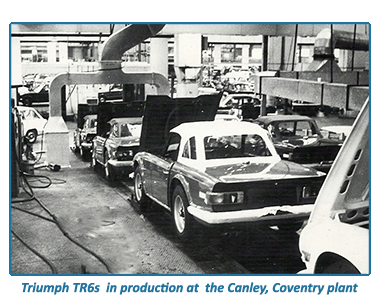 The engine was a 2498-cc six-cylinder engine in place of the trusty old 'four', fitted with Lucas electronic fuel injection system that produced 150 bhp.
The engine was a 2498-cc six-cylinder engine in place of the trusty old 'four', fitted with Lucas electronic fuel injection system that produced 150 bhp.
The Triumph TR5 PI cam with both roadster and hard-top coupe versions were available, with stiffer rear suspension, larger power brakes with a fail-safe device, and an improved interior.
This featured a non-reflective wooden fascia with round face-level air vents at each end, rocker control switches, Ambla upholstery and a very taut and flap-free weather-proof fitted hood.
An offset `TR5' badge on the bonnet and '2500' insignia on the rear wings above repeater flashers signified the new car's identity.
In August 1968 Triumph’s final releases of the decade began to appear, the first being the GT6 Mark II hardtop coupe.
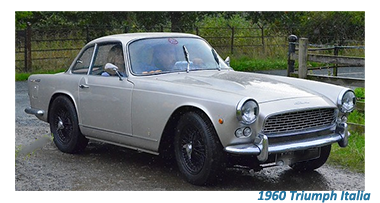 Externally the Mark II GT6 could be distinguished by its raised bumper, blanketing the radiator air intake in Spitfire Mark III style. Handling was vastly improved, and the GT6 became pleasantly fast and safe.
Externally the Mark II GT6 could be distinguished by its raised bumper, blanketing the radiator air intake in Spitfire Mark III style. Handling was vastly improved, and the GT6 became pleasantly fast and safe.
A similarly modified "IRS" system with only the dampers being different, was also adopted for the Vitesse Mark II.
By the end of the decade, Triumph were riding on the crest of a wave, among the top three UK car manufacturers, the only one of the three that was British owned, with the company having expanded their range to meet almost every demand from the UK and global markets.
Back to the homepage- and don't spare the horsepower.







